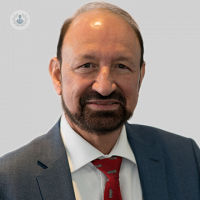Radiowave mole removal: how does it work?
Escrito por:Radiowave mole removal is a simple procedure using radiofrequency to remove moles, birthmarks, and skin tags. Radiowave uses high frequency and vaporisation rather than cutting. Other methods of mole removal use scalpel or lasers. Therefore the scars left behind after removal of the mole through radiowave is minimal to no scar at all. Aesthetic medicine expert Dr JJ Masani explains the technique he uses, which leaves fast, pain-free and scarless results...

How does radiowave mole removal work?
Radiowave mole removal works through using a very fine loop of platinum wire, which is as thin as your hair. The wire is used to brush the mole thereby vaporising the mole or the skin tag. As the fine platinum loop is waved with radiofrequency, it removes the pigments but also coagulates all the blood vessels. Therefore, there’s no bleeding during the procedure. There is no heat involved meaning there is minimal scarring.
What are the benefits of the procedure?
The main benefit of radio wave procedure is that it’s safe, pain-free, and the healing is pretty swift. As I only remove the pigmented tissue and avoid the dermis (the second layer of the skin), the great advantage again means that scarring is miniscule. Another benefit of radiowave is that because we are removing just the epidermis (the top layer) we can send the sample off to histopathology.
Prior to removing the mole, I always undertake dermoscopic pictures as well as dermoscopic view. Dermoscope is a specialized equipment which uses polarised light, meaning we are able to diagnose up to 2-3mm deep down under the skin if the mole is cancerous or not. If there was any doubt under the dermoscopic examination that the mole was cancerous, it would be sent to the laboratory to rule out skin cancer with a biopsy.
How long does mole removal take using radiowave surgery?
The actual mole removal is very quick. It takes less than five minutes to remove a mole. Before removing any mole, I take a full medical history and explain the procedure to the patient. After the consultation with the patient, I examine the mole under dermoscope just to make sure that it is non-sinister. Once the mole has been classified under a dermoscope, I can explain to the patient whether the mole needs to be removed or can be kept. Sometimes, a mole does not look nice and therefore the patient might decide for aesthetic reasons to remove it like seborrheic keratosis which is a benign mole and can be left but the patient may decide to have it removed for aesthetic reasons.
What are the risks?
There are no risks involved with the procedure but patients who have cardiac pacemakers cannot use it because cardiac pacemakers also use radio wave which will interfere with it. Before the procedure, I inject the area with an anaesthetic liquid so that no pain is felt during the procedure. Immediately after removing the mole, the skin will be flat and pink and healthy-looking. There will be a scab which will form and the scab will fall off within five to ten days.
After that, the skin will gradually come back to its normal colour, leaving minimal scar or no scar at all. Before leaving the clinic, the patient has cream applied and a flesh-coloured plaster which does not show. Therefore they can go about their normal activities straight away.
How much does radiowave mole removal cost?
The total cost of removing up to four moles, along with the consultation, is £550.


